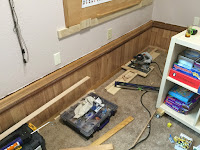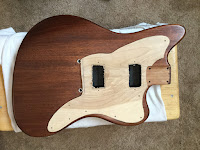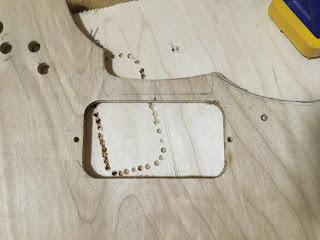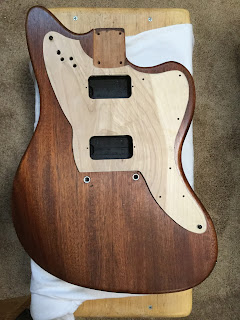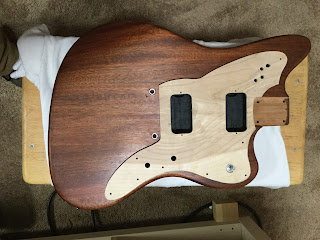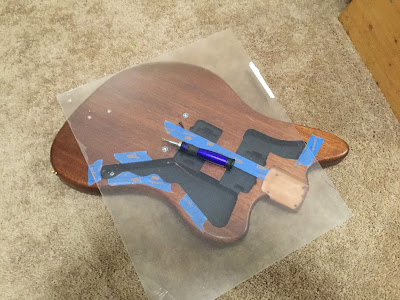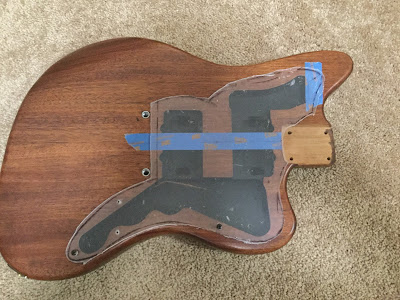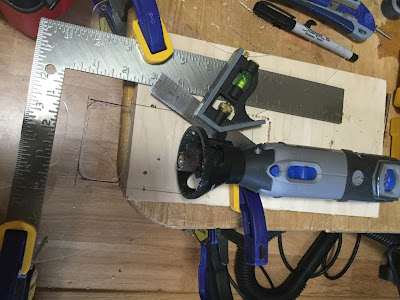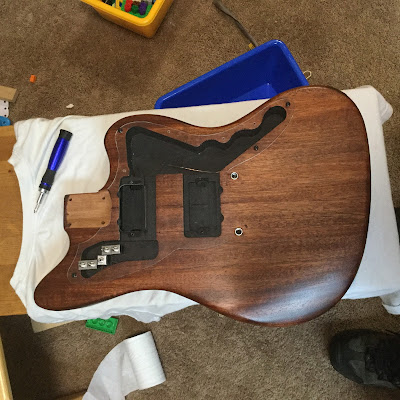So here is my hard work this weekend, in the corner is my jig for cutting baseboards serving as a 'weight to hold the board to the side while it's being glued . . . the other bits and pieces serve the same purpose as the wall ISN'T straight . . . and here is the UGLY concrete covered with 'fake' wood with the baseboard installed. And YES, I did finish both sides of the room, it now just needs a screen along the top to cover the gap there . . .
Oh, you aren't here to admire my work in rehabbing our converted garage . . . uhmm . . . sorry . . . .
So this is where things ended this weekend . . . and here is how we got there . . .
I don't what to ruin my nice laminated piece so I went on with the plywood to see what problems I could run into when making the REAL thing . . .
So first the dremel got a workout finishing up the edge of the THING
Nice job . . . the bridge end will be done later after I verify the location of the posts . . . don't want to do it twice and don't want to take off to much.
Next ... holes for the pickups . . . well I can cut them freehand but we all know how that will end up with my hands so . . . first a jig, need a 1.5+7/8+7/8 by 2.75+7/8+7/8 = 1 4/8+14/8 by 2 3/8+14/8 = 3.25 x 4.25 . . . I think (it's from memory so go look up the dimensions before you use these . . . they MAY be wrong - the 7/8 is the distance from the sanding drum to the edge of the dremel cutting guide). The first pic are the first glue joints . . . just butt ends on pieces cut exactly to size . . . measure . . . measure . . . measure . . . cut and measure and sand and measure, well you get it by now I'm sure . . . . The 2nd photo is the final glue joint with pieces of hawthorn profile (I had a short waste piece hanging around) going over the butt joints to reinforce . . . . . clean off the excess glue . . . lightly sand . . . wouldn't want to change those carefully set dimensions.
So cutting the actual holes is next . . . .
Roughed out holes on the left AND . . . . . . . the finished product one the right . . . . what did I say about measuring, I went with the cross through the center of the pickup . . . and didn't check against the holes for the pickup screws which had been drilled previously . . . . . . . one OR the other was NOT exactly where it should have been as I'm dead on neck to butt but off by 0.75 mm left to right . . . . . . ALL together now . . . . . . MEASURE . . . . .
So holes for controls next . . . .
And here are the ones for the selection of the coils in the pickups . . . . the eagle eyed once again can spot the mistake . . . yes the top left hole does look 'weird' . . . the original was off by 1/16 (or a bit less) but as the switches 'kiss' each other that's enough for some rather nasty words . . . MEASURE . . . although this time I did and still got it wrong . . . . that's why I make JIGS and then test the JIGS . . .
So here are the holes for the volume and tone controls drilled and . . . that's the rotary switch installed . . . turns out there is an added problem with that one . . . more than one actually .. .. .. it's (probably) metic so a 3/8 hole is just a might bit to large - use a 5/16 next time - and the shaft on the piece is NOT long enough to fit through the 1/4 ply thus:
My first attempt at recessing with the dremel and a rotary bit set to about 1/2 the thickness of the ply . . . drew around the washer and cut freehand . . . not perfect but a credible attempt I think and any imperfections are covered by the knob . . . . . .
So that was Sunday at 6 PM when I called it quits . . . more next week . . . 3 more switches to locate and a whole lot of soldering . . . .
Oh and for the bottom below the wood part of the guard . . . maybe some of this
Hmm maybe a bit too wild . . . . . .
